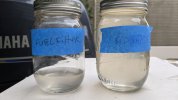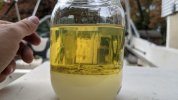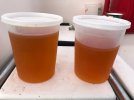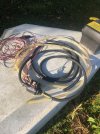Hey call, I hope everyone is doing good here! It's been awhile.
Apparently my bilge pump did not work during this last storm in Norther NJ. So today I just went to do my routine, check on the boat after a storm and found that the bilge was complexly over flowing and I had about 2-4 inches of water above the deck, aft of the boat. The water came up about half way up the batter case.
I went and turned the batteries on and hit the bilge switch manually. The bilge kicked on, even though it was dumping out beneath the water line! It took a little bit but eventually I was able to dump the water out of the bilge and the deck. I turned the motor on, everything started up fine - decided to take the boat out of the slip and just get the bow up and let all the water run out. Now I knew I was low on fuel to begin with, not sure if this is important or not - but after about 5 minutes, ow up and bilge going - the alarm goes off. No lights on the dash but I stopped and shut down the engine. Waited a little bit, turned the key on.. no lights, temp gauge and oil gauge all good. Started up the engine and heading back to slip. Half way through, the motor starts chugging, like bad gas or something. Finally it dies and I had just enough motion to get me to slide into an empty slip.
Tie up.. check everything out, turn the key on, didn't even try to start it, alarm starts blaring. No lights on the dash - just the alarm. From what I am guessing, water in the system somehow? The other weird thing is the gas gauge is whacked out.. it's reading and pinned past full, like a bad fuel sender. Remember I mentioned I was low on fuel before? Could water have got into my gas tank and filled up? What;'s my next best course of action to check here?
Apparently my bilge pump did not work during this last storm in Norther NJ. So today I just went to do my routine, check on the boat after a storm and found that the bilge was complexly over flowing and I had about 2-4 inches of water above the deck, aft of the boat. The water came up about half way up the batter case.
I went and turned the batteries on and hit the bilge switch manually. The bilge kicked on, even though it was dumping out beneath the water line! It took a little bit but eventually I was able to dump the water out of the bilge and the deck. I turned the motor on, everything started up fine - decided to take the boat out of the slip and just get the bow up and let all the water run out. Now I knew I was low on fuel to begin with, not sure if this is important or not - but after about 5 minutes, ow up and bilge going - the alarm goes off. No lights on the dash but I stopped and shut down the engine. Waited a little bit, turned the key on.. no lights, temp gauge and oil gauge all good. Started up the engine and heading back to slip. Half way through, the motor starts chugging, like bad gas or something. Finally it dies and I had just enough motion to get me to slide into an empty slip.
Tie up.. check everything out, turn the key on, didn't even try to start it, alarm starts blaring. No lights on the dash - just the alarm. From what I am guessing, water in the system somehow? The other weird thing is the gas gauge is whacked out.. it's reading and pinned past full, like a bad fuel sender. Remember I mentioned I was low on fuel before? Could water have got into my gas tank and filled up? What;'s my next best course of action to check here?






